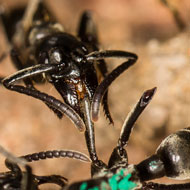When the ants get back to the nest, they treat the open wounds of their fellows by ‘licking’ them intensively, sometimes for several minutes.
Study reveals ants rescue their fellows and treat open wounds
New research shows that African Matabele ants not only rescue their injured comrades, they also tend to their wounds - a behaviour which is thought to be unique in the animal kingdom.
Without this ‘medical treatment’, scientists say 80 per cent of the injured ants die; but with it, only 10 per cent succumb to their injuries.
Matabele ants face a high risk of injury every day. Widely distributed in Sub-Saharan Africa, the ants set out to raid termites two to four times a day. Long files 200 to 600 ants raid termites at their foraging sites, killing many workers and hauling their prey back to the nest.
However, the ants meet fierce resistance from the well-armoured termite soldiers, which have powerful jaws to fend off attackers. Ants often lose limbs that are bitten off.
Wounded ants are able to ‘call for help’ by excreting a chemical substance, so their fellow ants will carry them back to the nest. This ability was discovered last year by Erik T Frank from the Julius-Maximilians-Universität Würzburg (JMU) in Bavaria.
Now, Würzburg researchers have made a further discovery. When the ants get back to the nest, they treat the open wounds of their fellows by ‘licking’ them intensively, sometimes for several minutes.
“We suppose that they do this to clean the wounds and maybe even apply antimicrobial substances with their saliva to reduce the risk of bacterial or fungal infection,” Frank explained.
Interestingly, badly injured ants missing five of their six limbs, for example, will not call for help. If attempts are made to rescue them, they struggle and lash out wildly, refusing to cooperate with their helpers so that they are left behind. This means that no energy is wasted in rescuing ants that cannot be saved.
By contrast, slightly injured ants pull in their limbs to facilitate transport. They also move much more slowly than normal once potential helpers are near. Scientists believe this could increase their chances of rescue as they are more noticeable compared to other fast-moving ants rushing back to the nest. Or, it could be that ants can localise the ‘save me substance’ more easily in resting insects.
The research paper has been published in the journal Proceedings of the Royal Society B.
Frank and his team will now tackle further questions thrown up by the research, such as: How do ants locate injured mates?� How do they know when to stop dressing wounds? Is treatment purely preventative, or also therapeutic?
Image © Erik T Frank







 The Greyhound Board of Great Britain has published new vaccination guidance, with all greyhounds registered from 1 January, 2027 required to have the L4 leptospirosis vaccination, rather than L2.
The Greyhound Board of Great Britain has published new vaccination guidance, with all greyhounds registered from 1 January, 2027 required to have the L4 leptospirosis vaccination, rather than L2.
